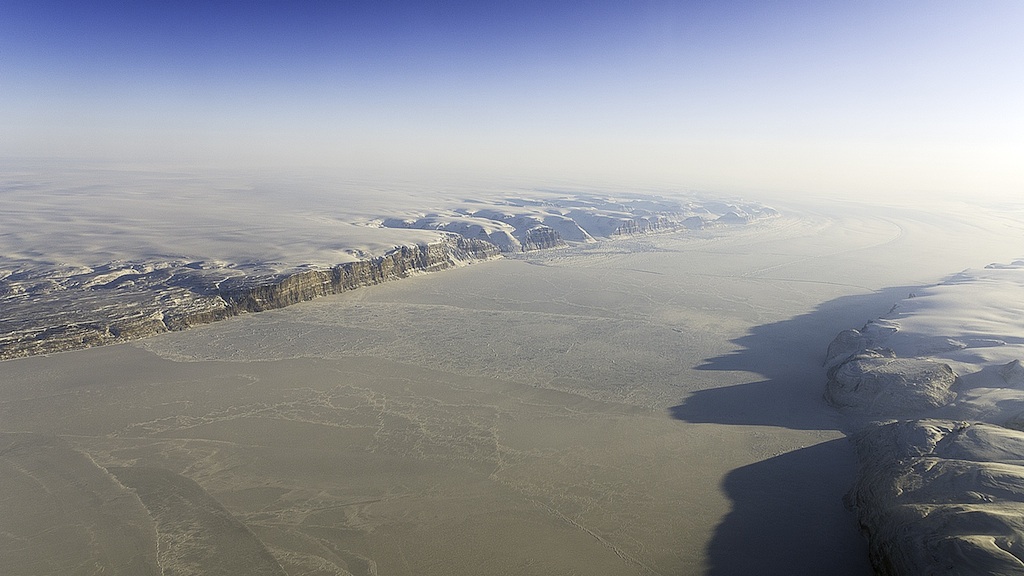Ice Flow toward the Petermann Glacier, Greenland
Greenland looks like a big pile of snow seen from space using a regular camera. But satellite radar interferometry helps us detect the motion of ice beneath the snow. Ice starts flowing from the flanks of topographic divides in the interior of the island, and increases in speed toward the coastline where it is channelized along a set of narrow, powerful outlet glaciers. In the east, these glaciers make their sinuous way through complex terrain at low speed. They form long floating extensions that deform slowly in the cold north. As we move toward sectors of higher snowfall in the northwest and centre west, ice flow speeds increase by nearly a factor 10, with many, smaller glaciers flowing straight down to the coastline at several kilometers per year.
This complete description of ice motion was only made possible from the coordinated effort of four space agencies: the Japanese Space Agency, the Canadian Space Agency, the European Space Agency, and NASA's Jet Propulsion Laboratory. The data will help scientists improve their understanding of the dynamics of ice in Greenland and in projecting how the Greenland Ice Sheet will respond to climate change in the decades and centuries to come.
This animation shows how ice is naturally transported from interior topographic divides to the coast via glaciers. The colors represent the speed of ice flow, with areas in red and purple flowing the fastest at rates of kilometers per year. The vectors indicate the direction of flow.

A print resolution still of the vector flow over Northwest Greenland to the Petermann glacier.

Ice flow colortable on a logarithmic scale.
Credits
Please give credit for this item to:
NASA/Goddard Space Flight Center Scientific Visualization Studio
The topographic data of Greenland is provided courtesy of Ian Howat, The Ohio State University, Columbus, OH.
The MOG mosaic (MODIS) is courtesy of T. Scambos, NSDIC, Bouder, CO.
-
Visualizer
- Cindy Starr (Global Science and Technology, Inc.)
-
Animators
- Horace Mitchell (NASA/GSFC)
- Greg Shirah (NASA/GSFC)
-
Producer
- Matthew R. Radcliff (USRA)
-
Scientists
- Eric J. Rignot (NASA/JPL CalTech)
- Jeremie Mouginot (University of California, Irvine)
- Ian Howat (Ohio State University)
- Ted Scambos (NSIDC)
-
Project support
- Laurence Schuler (ADNET Systems, Inc.)
- Ian Jones (ADNET Systems, Inc.)
Release date
This page was originally published on Thursday, October 18, 2012.
This page was last updated on Wednesday, May 3, 2023 at 1:52 PM EDT.
Missions
This visualization is related to the following missions:Papers used in this visualization
https://agupubs.onlinelibrary.wiley.com/doi/epdf/10.1029/2012GL051634
Datasets used in this visualization
-
BMNG (Blue Marble: Next Generation) [Terra and Aqua: MODIS]
ID: 508Credit: The Blue Marble data is courtesy of Reto Stockli (NASA/GSFC).
This dataset can be found at: http://earthobservatory.nasa.gov/Newsroom/BlueMarble/
See all pages that use this dataset -
GIMP Greenland DEM (Greenland Mapping Project (GIMP) Digital Elevation Model)
ID: 746 -
Digital Mosaic of Ice Motion in Greenland
ID: 747Digital Mosaic of Ice Motion in Greenland from satellite radar interferometry data acquired during the International Polar Year 2008 to 2009 by the Envisat Advanced Synthetic-Aperture Radar (ASAR), the Advanced Land Observation System (ALOS)'s Phase-Array L-band SAR (PALSAR) and the RADARSAT-1 SAR
See all pages that use this dataset -
Greenland Ice Sheet Velocity
ID: 770Assembled from satellite radar interferometry data acquired during the International Polar Year (2008-2009). The satellites are Envisat Advanced Synthetic-Aperture Radar (ASAR), Advanced Land Observation System's (ALOS) Phase-Array L-band SAR (PALSAR), RADARSAT-1 SAR
See all pages that use this dataset
Note: While we identify the data sets used in these visualizations, we do not store any further details, nor the data sets themselves on our site.
